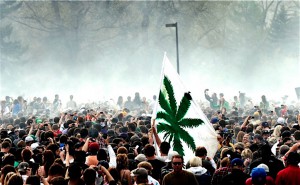
Marijuana advocates celebrate "4/20" annually by smoking pot. Researchers say that traffic fatalities rise by 12% that day. Photo credit: Daily Camera
Each year on April 20, thousands of people in the United States celebrate 4/20, the date 2o-plus years ago that High Times, a marijuana advocacy publication, designated to celebrate what it perceived as the virtues of smoking pot.
However, a new study shows that it’s not only people that get high on that day, traffic fatality rates get high(er) as well.
Actually the results of the study are more educated guess than stone cold fact. Researchers cannot not fully determine if marijuana-intoxicated drivers caused the rise in vehicle deaths on 4/20, but they appear to be the most likely culprits, according to John Staples, an internist and researcher at the University of British Columbia in Vancouver.
“The simplest explanation is that some drivers are impaired by cannabis use, and these drivers are contributing to fatal crashes,” he told Reuters. “There should be very clear messaging to the public: Don’t drive high.”
(More Americans willing to trust self-driving vehicles, new study shows. Click Here for the story.)
The impact of marijuana’s psychoactive effects on drivers is of on the radar of safety advocates and other organizations with the rise in the number of states that have made recreational use legal. Currently, eight states and the District of Columbia permit marijuana to be sold for recreational use to customers at least 21 years old.
The “High Holiday” became popular after a story from High Times in 1991. The publication told the story of five San Rafael High School students, who claimed to come up with the term “4/20” after regularly meeting at 4:20 p.m. in 1971 to hunt for pot plants in a nearby forest.
(Click Here to see why high-tech safety gear is cutting down on accidents, but causing insurance rates to rise.)
Researchers analyzed U.S. National Highway Traffic Safety Administration fatality reports from 1992, the year after the High Times story, through 2016. Traffic fatalities were 12% higher on April 20 after 4:20 p.m. than on the same day one week before or one week after.
More importantly, young drivers seem to be impacted the most, according to the study, which showed that fatal crashes were 38% more likely for drivers under 21 years old after 4:20 p.m. on April 20 than they were the week before or after, Staples said.
(To see more about the push to lower minimum BAC for drunk driving, Click Here.)
Currently, every U.S. state prohibits driving impaired by marijuana, Jennifer Whitehill, a professor of health promotion and policy at the University of Massachusetts Amherst, who was not involved with the study, told Reuters. However, many groups that host festivals are working to ensure safe-driving measures, such as free rides, taxis and other low-cost travel options are available. In fact, in Colorado, which was the forefront of the legal recreational movement, Lyft, the ride-sharing service, last year launched a fleet of green cars wrapped with the message: “Plan a ride before you’re high.”
